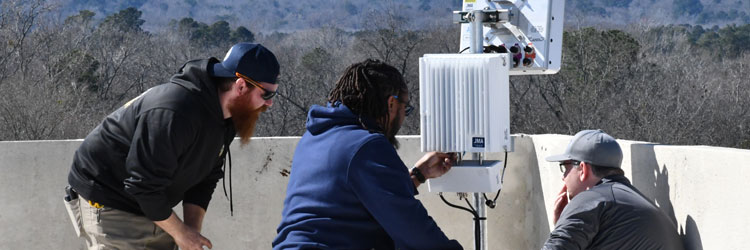This month, Pierson Wireless will address a number of topics related to the best practices in the design and implementation of Emergency Responder Communication Enhancement Systems (ERCES) – also known as Public Safety DAS (Distributed Antenna System).
The single most important reason Public Safety DAS exist and are necessary is to ensure critical in-building communications between members of first responder teams that can mean the difference between life and death as they coordinate and execute emergency response tactics.
First responders coordinate efforts via radio signals broadcast within government-mandated frequency ranges, normally in the VHF, UHF, 700, and 800 MHz bands. A Public Safety DAS leverages a donor antenna to receive RF transmissions from public safety network towers. In turn, those signals are collected, amplified, and rebroadcast within the structure via a distributed network of antennas.
The preponderance of steel, concrete, and low-emissivity (Low-E) glass in modern construction creates many challenges for a reliable signal in large venues or multiple-level buildings. The density of materials, coupled with the square footage within the structure, makes it difficult for first responder radio signals to penetrate and populate the entirety of the space. As a result, municipalities are updating codes to make the presence of a Public Safety DAS mandatory and a requirement of occupancy.
Today’s look at best practices utilized by the Pierson Wireless Public Safety team takes a look at the differences between Class A and Class B bi-directional amplifiers (BDA).
CLASS A VS. CLASS B BI-DIRECTIONAL AMPLIFIERS
The Federal Communications Commission (FCC) refers to amplifiers designed to retransmit public safety signals as signal boosters, and they are classified into two types: Class A and Class B. Both classes are governed by FCC Part 90 and must meet the National Fire Protection Association (NFPA) and International Fire Code (IFC) code requirements. However, both amplifier classifications are very similar in construction and capabilities, and Authorities Having Jurisdiction (AHJ) and Frequency License Holders can be particular about which one is used to service their public safety networks for many different reasons.
There are many questions around Class A and Class B. What is the difference between them? Does one perform better? Which one is cheaper? How much noise does each one generate? Can one be used for all applications?
The FCC differentiates Class A from Class B amplifiers by the maximum bandwidth of the channel filter. Simply put, the class designations break down as follows:
Class A is designed to retransmit signals on one or more specific channels and is limited to a maximum filter bandwidth of 75 kHz per channel.
Class A Filtering

Frequency
Class B is designed to retransmit any signals within a wide frequency band and are all other amplifiers whose filter bandwidth is greater than 75 kHz per channel.
Class B Filtering

Frequency
As far as classification goes, that is all there is, but that does leave some questions unanswered.
Class A amplifiers are known as channelized, and Class B are referred to as wideband. Most Class A amplifiers can be programmed for 32 individual channels, with some models offering more depending on the frequency band. Class B can be programmed for two channels per frequency band, depending on filter bandwidth.
Both Class A and B can come in variants from ½-watt up to a maximum of five (5) watts. While they both provide the same level of total amplification, Class A boosters dedicate most of that power to the individual channels used by the public safety network.
Class B, on the other hand, allocates equal power to all signals within the filter’s bandwidth. This leaves Class B amplifiers susceptible to inefficiencies due to the amplification of these unwanted signals.
These unwanted signals, also called spurious, can make booster output fluctuate in heavily used radio frequency (RF) environments, such as urban areas, making optimization and output power management difficult. The saving grace of a Class B amplifier is that these large bandwidths accommodate a considerable number of channels. So, if there are more channels than a Class A unit can handle, Class B offers the most cost-effective solution when the channels are in close alignment, and there are no unwanted strong interfering signals in the range of the filter’s bandwidth.
The other primary consideration between Class A and Class B is the noise generated. Class A can only transmit when the amplifier detects a signal and then mutes the channel. Class B does not have this capability and must be in an always-on state. This has a greater potential of generating noise for the public safety network or any other networks used in the filter’s bandwidth.
Since Class B boosters are more likely to cause noise to surrounding sites, they must be registered with the FCC upon installation and before turn-up. This adds another step to the process, but the upcoming standards will require this for both Class A and B boosters.
Pricewise, Class A amplifiers tend to cost more than Class B due to the filters used in construction. However, Class B ERCES configurations may require more power in a like-for-like comparison to compensate for the inefficiency caused by amplifying spurious or unaffiliated signals.
In summary, there is no “one-size-fits-all solution” when it comes to the best choice for a public safety bi-directional amplifier. The decision should be made based on the AHJ’s requirements, the number of channels needing amplification, and specifics of the local network environment to ensure the best functionality.
Pierson Wireless is an industry leader in ERCES and Public Safety DAS solution design, implementation, and system monitoring. To learn more about our expertise in the space or to schedule a consultation, visit our Public Safety resource page.























Leave A Comment